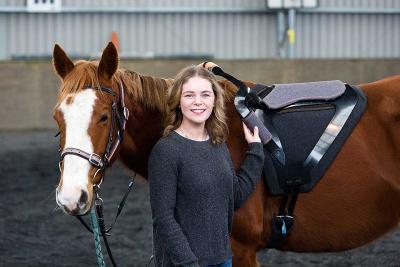Industrial design graduate Holly Wright’s specialised saddle for disabled riders has won the top prize in the New Zealand section of the 2018 James Dyson Award.
She is only the second woman in the 18-year history of the competition to win the award, following the success last year of Nicole Austin – a fellow graduate from Massey University’s College of Creative Arts.
“That’s a great step for us girls,” Ms Wright said. “There’s no reason why we can’t be as good or better [than male] designers.”
The global product design competition celebrates, encourages and inspires the next generation of design engineers.
Ms Wright’s saddle, called Contak, focuses on safety, experience and adaptability for the rider, volunteers and the horse involved.
Last year her design was awarded a gold pin by the Designers Institute of New Zealand at the Best Awards and a Best of the Best Award at the Red Dot Awards in Singapore.
Working with Hutt Valley staff from the national charitable organisation Riding for the Disabled, Ms Wright saw the opportunity to improve the assisted therapy experience for disabled riders and their volunteer walking helpers by analysing and rethinking the existing equipment.
Riders are accompanied by walkers on either side of the horse as well as a third person leading.
With multiple half-hour sessions in a day, walkers work with numerous riders with different needs requiring different equipment. There was an obvious need for simple, adaptable and effective equipment, Ms Wright says.
“My saddle design brings the rider 60 per cent closer to the horse which is important as the rider responds to the movement and gait of the horse. The further away from the horse they are it’s less stable and riskier.
“Putting a rider on a horse gives the rider the feeling of walking without assistance and means they are effectively walking on the same plain as able-bodied people.”
The saddle features an elevated grasp handle for the rider that moves back and forward, adding to the therapeutic benefits of riding by engaging the muscles of the core. The close contact and direct connection between horse and rider, allows heat transfer between the horse and rider resulting in positive physical therapy that relaxes and lengthens the large muscle groups in the rider’s legs.
“This is of immense benefit to children affected by cerebral palsy or other physical disabilities where the muscles are tightened or in spasm,” she says.
Her saddle design also provides a movable side grip to help when walking alongside the horse and relieves stress on the arm of the side walkers.
“The response was, ‘That’s going to save us a lot of pain’,” Ms Wright says.
It also potentially eliminates the need for one walker freeing them up to work with other clients at Riding for the Disabled.
Her design has been further enhanced with her choice to use a high-density polyethylene plastic, foam and felted wool, rather than wood and leather used in conventional saddle design.
“It will fit any shaped horse of any size because the shell material is so flexible,” she says.
Winning the national leg of the James Dyson Award will inject $3,500 into the development of Holly’s design. She plans to continue collaboration with local Riding for the Disabled centres to develop the saddle further. Prize money from the James Dyson Foundation will aid the manufacture of a small run of prototype saddles for local testing. Market research suggests that a niche international market could be anticipated.
Expressing delight at her win, Ms Wright says although she is involved in recreational riding “I had no prior experience in the therapeutic use of horses but recognised an opportunity to improve safety and therapy benefit through a new saddle design.
“Moving forward I want to continue collaboration with local RDA centres to develop the saddle further and hope present Contak at the bi-annual therapeutic riding conference in South East Asia in late 2019.”
Runners-up for the award included another Massey industrial design graduate, Georgia Fulton, who designed a sensor jacket for farm pigs that prevents piglets from being crushed by sows. The design works by using sensory technology to increase piglet survival rates and train the sow to prevent further crushing happening. Farmers are able to keep the pigs outside on the farm safely, encouraging farmers to shift away from controversial indoor systems.
A trio of Victoria University industrial design graduates who were also runners-up, Ana Morris, Courtney Naismith and Glen Askey developed a digital healthcare system that monitors fluid levels in medical drains and notifies patients and caregivers through a wearable device and an app.
Ms Wright’s winning entry will be part of a pool of global winners which will go forward to a shortlist to compete for the James Dyson International Prize, being presented in November, and worth around NZ$60,000. The tertiary institution the international winner represents is awarded about NZ$10,000.

